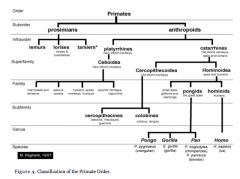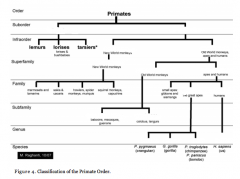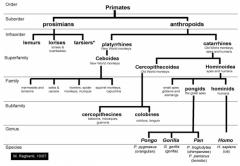![]()
![]()
![]()
Use LEFT and RIGHT arrow keys to navigate between flashcards;
Use UP and DOWN arrow keys to flip the card;
H to show hint;
A reads text to speech;
24 Cards in this Set
- Front
- Back
|
Describe the scientific names of any primates we’ve covered in lab in binomial nomenclature.
|

This system uses the genus and species to give each species a distinct name in latin that can be recognized worldwide, regardless of the language spoken.
Pongo Pygmaeus Gorilla Gorilla Pan Triglodytes (chimp) Pan Paniscus (bonobo) Homo Sapien (if you don't know this, drop out of college) |
|
|
Compare and contrast the concepts homology and analogy in an evolutionary context.
|
A <homology> is a trait which two animals share because of their shared ancestry. An example is the vertebral column present in all vertebrate animals.
In contrast to homologies, <analogies> are traits that seem to be similar between two different animals, but have actually evolved in parallel in two different evolutionary lineages. Bats and Birds have similar bone structure but no similar ancestry. |
|
|
Define the order Primates using derived traits common to its members.
|
An opposable great toe (Humans are an exception!)
Nails instead of claws on hands and feet An auditory bulla derived from the petrosal bone An increased reliance on vision, including the ability to perceive distances (stereoscopic vision) and color. This reliance has a suite of associated neurological and anatomical traits A postorbital bar, a ring of bone that surrounds the eye, stabilizing it and isolating it from the actions of the chewing muscles A decreased reliance on the sense of smell when foraging for food or looking for mates An extended period of juvenile development, and remaining in a natal group for a longer period of time A smaller number of infants (usually only one) born per birth An enlarged brain relative to body size Increasingly complex social organization and behavior |
|
|
What makes a primate a primate?
|
Larger body size
Larger brain size Decreased reliance on smell Increased reliance on olfaction Long gestation Increase reliance on learned behavior. |
|

Explain the primate taxonomy as covered in the lab manual or in your lab.
|

(In order to accomplish this, referring to the taxonomies on page 100 of your manual and in the file “Living Primates” in the folder Week 10 - Primate Behavior (found in Module 3) is highly recommended.)
|
|
|
Strepsirrhini (Prosimians)
|
Unique physical traits of animals in this group: grooming claw, tooth comb, etc.
|
|
|
There’s one primate that, based on skeletal traits, doesn’t fit into this group, yet the traditional taxon (i.e., prosimians) contains this lilliputian misfit. Which primate is this?
|
Tarsiers have a bony septum, no tapedum lucidum, no moist rhinarium, and DNA evidence places them closer to anthropoids.
|
|
|
Strepsirhini
|
A dental toothcomb, used for social and solitary grooming
Grooming claw on the 2nd toe Reliant on smell Scent glands Moist rhinarium (nose) nocturnal Has a tapetum lucidum |
|
|
Haplorrhini (Anthropoids)
|
Dry nose
more derived traits Postorbital septum EX: Tarsiers, NWM, OWM, Apes Dinural No tapetum lucidum |
|
|
Catarrhini
|
Downward directed nostrils
2.1.2.3. Bony ear tube (Eustachian tube) |
|
|
Platyrrhini
|
Nostrils face outward
2.1.3.2. or 2.1.3.2. Lack bony ear tube Prehensile tail Tree dwellers |
|
|
Hominoidea
|
Superfamily
includes humans go wild |
|
|
Using provided descriptions, classify primates into one of the social organizations listed on page 120.
|

|
|
|
Nocturnal
|
Awake at night.
|
|
|
Diurnal
|
Awake during the day.
|
|
|
Cathemeral
|
Being active at any given time during the day or night.
|
|
|
Crepuscular
|
Being active only at dusk or dawn
|
|
|
Classify primate taxa as either specialists or generalists based on provided verbal descriptions of their diets.
|
Specialists: “Organisms that display a
narrow pattern of resource usage.” Sympatric species: species “occurring together in the same geographic area. Generalists: “organisms that display a broad pattern of resource usage.” |
|
|
What is the most sexually dimorphic bone in the human body? In other words, which bone is the best for determining the sex of a skeleton?
|
Pelvis
Using: Subpubic Angle Greater sciatic notch Wide versus narrow sacrum |
|
|
What other skeletal features help you determine the sex of an individual?
|
Slanting of the frontal bone
Size of the mastoid process superior margin of the eye orbit |
|
|
What's the difference between the epiphysis and the diaphysis?
|
Epiphysis is the rounded end of a long bone; the secondary center of ossification
Diaphysis is the shaft of the long bone; the primary center of ossification |
|
|
Why are some bones fused and not others?
|
Bones fuse as an individual ages, and fusion varies between bones and individuals. that is why aging a skeleton is not an exact science.
|
|
|
What is the "traditional" primate taxonomy versus the new primate taxonomy? Why did it change?
|
Traditional taxonomy splits primates into the suborders:
prosimians and anthropoids. The new taxonomy moves tarsiers to the anthropoid side, and renames the two groups: strepsirhines (prosimians) and haplorhines (anthropoids + tarsiers) |
|
|
What is a primitive versus a derived trait?
|
Primitive traits are traits than an animal shares with its ancestors.
Derived traits are traits that are not shared with an animals ancestors. |

